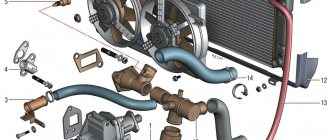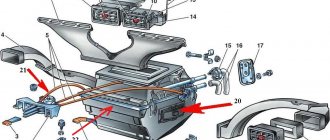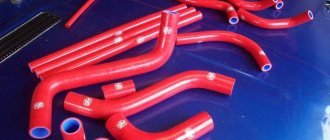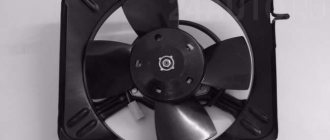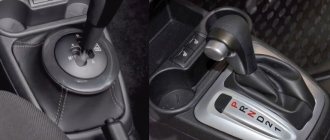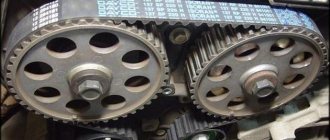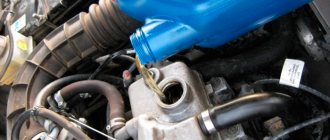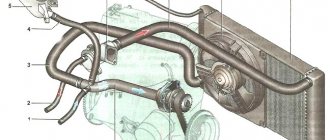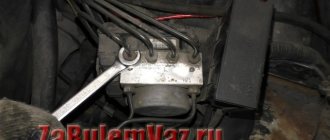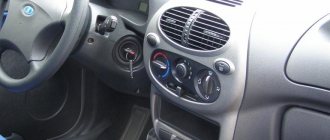Elements of the Lada Granta cooling system
- stove heater radiators;
- electric pump;
- engine;
- throttle assembly;
- thermostat;
- antifreeze temperature sensor;
- overheat indicator;
- viscous fan drive coupling;
- fan;
- radiator cap;
- radiator;
- expansion tank cap;
- expansion tank;
- water pump;
- drain valve of the lower circuit.
And also, pipes of the Lada Granta cooling system, metal clamps - ties.
Thermostat
The cooling device on the Lada Grant is the main link in the chain. Performs the function of a valve that redirects the flow of antifreeze from a small to a large circle. When the operating temperature is below 94°, the thermostat is in the closed position. The liquid circulates in a small circle without “entering” the radiator.
New thermostat
According to this movement pattern, the heating of the liquid occurs many times faster. When the antifreeze heats up, the valve opens slightly, starting circulation in a large circle into the water jacket line.
Most often, a thermostat malfunction is associated with its boiling or jamming due to overheating. The part cannot be repaired; it must be replaced with a new, serviceable one.
Water pump (pump)
Forces antifreeze to circulate through the jacket (system). Structurally, the pump is located inside the engine, closer to the gas distribution mechanism (GRM). Moreover, it has a common drive with the timing belt.
Water pump
The average service life of the pump is 80 – 85 thousand km. Due to the frequent violation of regulations by the driver, the purchase of cheap analogues instead of original spare parts, the part wears out prematurely.
Radiator and fan
Cooling radiator
The radiator is designed to cool antifreeze. The standard fan also performs this function, but only after the operating temperature reaches a critical level of 100°.
Fan
How quickly the fan activates depends on the health of the temperature sensor. The latter monitors the degree online and sends the readings to the electronic engine control unit (ECU) to adjust the operation of the mechanisms.
Failure of the sensor leads to boiling of the engine. Many car owners have encountered this problem.
Connecting hoses and water jacket
Hoses serve as a link, connecting all mechanisms to each other. Frequent malfunctions are associated with a violation of the integrity, tightness of the system, and low levels of antifreeze.
Cooling system pipes
The water jacket is designed to circulate antifreeze throughout the system and remove excess heat. Damage to the jacket will result in water hammer inside. When using antifreeze, the risk of water hammer is 27% lower, in contrast to distilled water.
Expansion tank
The fluid level in the cooling system decreases and increases depending on the actual temperature. To compensate for the amount of antifreeze, an expansion tank is pre-installed in the design of the cooling system.
Expansion tank
The accessory material is heat-resistant polymer. On the outer surface there is a gradation of scales: minimum, maximum, recommended level. The tank is sealed with a sealed lid with a gasket.
When the pressure in the system reaches 1.1 kgf/sq. cm, the valve opens and releases the excess. The pressure in the system stabilizes. When the temperature of the liquid drops, to prevent vacuum, the inlet valve opens and replenishes the missing amount of air. How much antifreeze is in the Lada Granta cooling system: 7.5 liters up to about and 8.0 liters up to the recommended level.
Hidden problems
You have looked at everything and everyone, there are no leaks anywhere, all the hoses and clamps are in order, but the antifreeze or antifreeze goes away, “even if you crack”! The fact is that there are not only open leaks, but also so-called hidden ones, and they are much more dangerous.
A car engine is not a cast structure - there is a separate engine block and cylinder head. There is a gasket between these two parts, this is mandatory, it is high-temperature (can maintain high positive values), and it is also a sealing link. In the engine block, as well as in the cylinder head, there are channels through which antifreeze (antifreeze) passes, cooling the metal, thus the “entire engine” is at an operating temperature that does not exceed 90 - 100 degrees Celsius, without this fluid the engine would very quickly warmed up and it simply jammed.
So, the coolant also passes through the gasket, since it is an intermediate link (by the way, it has special channels). If the gasket is defective or poorly tightened, the tightness of the channels is broken and coolant can pass into the engine cylinders. That is, it will enter the combustion chamber, then through this chamber it will exit into the exhaust pipe, while the level of antifreeze (antifreeze) will decrease in the expansion tank.
What are the signs of such a breakdown?
In this case, it is 100% a gasket; we must change it. After all, sometimes antifreeze or antifreeze can get into the engine oil, and this is serious! Here the capital is just a stone's throw away.
Bottom line - if antifreeze or antifreeze goes into the engine, driving is prohibited!
This is reason number “1”, however, antifreeze can also flow through various channels of the cooling system. They also have gaskets adjacent to the engine block and when they wear out they leak.
Cooling system Lada Granta - 8 and 16 valves, with and without air conditioning
| Name | Peculiarity |
| The engine cooling system (hereinafter referred to as SOD) of the Lada Granta family is completely identical to the Lada Kalina | Heater radiator, single-pass, low resistance, aluminum, brazed, high efficiency |
| The radiator is built into a small circuit, unlike previous generations | |
| The thermostat has one valve, not two, as was previously the case | |
| The thermostat controls the flow of antifreeze through the radiator | |
| The interior heating system has been improved by removing more heat from the heater radiator | Increased flow of antifreeze through the radiator at a small circle of rotation |
| One-way passage pattern instead of two-way | |
| Aluminum pipes are flat instead of cylindrical | |
| Soldering is used at all stages of articulation | |
| No chance of airing | Changing the angle of inclination of the antifreeze supply/return lines |
| Improved aerodynamic performance | |
| Fine tuning of engine operating temperature | |
| Increased operational efficiency due to | Changes in ignition timing |
| Economical fuel consumption mode |
Checking the radiator for leaks
The diagnostic process is not at all complicated; we carry it out ourselves, and if you don’t have free time, visit a service station to have the work performed by professionals.
Checking the radiator from the engine compartment side
- We place the car within the perimeter of the repair area, on the inspection hole, and open the hood.
- From the engine compartment side, we inspect the surface of the radiator for drips and traces of antifreeze (antifreeze) leakage.
- We carry out similar actions from under the bottom of the car;
- We inspect the antifreeze supply/return lines, upper and lower circuits.
The most common places for depressurization: corners around the perimeter, joints, ties with clamps.
How to drain antifreeze from the cooling system of a Lada Granta
- The hood is open, the car engine has cooled down to a safe temperature so as not to damage the skin.
- We unscrew 6 screws from under the bottom and remove the oil pan protection.
- Unscrew the drain plug in the lower circuit of the radiator.
- At the same time, unscrew the drain plug on the wall of the cylinder block. We substitute the container.
We unscrew the plastic drain plug of the radiator tank.
Note to the driver!
The Lada Granta version has 8 valves. Place the container for testing below the ignition module, under the cylinder block (nut at “13”).
In the Lada Granta 16-valve, we first dismantle the starter, since it prevents free access to the plug. If you do not remove the starter, antifreeze will flood the part, temporarily rendering it unusable.
- After the liquid is completely drained from the water jacket, screw in the drain plugs. Fill in new antifreeze in a volume of 7.5 liters to about or 8.0 liters to the recommended average level.
Clear downgrade problems
This is not entirely relevant to our question, but it’s worth mentioning. This needs to be checked first, and if you have not identified the reasons, then we will dig deeper. So, antifreeze may leak due to a leak in the system, let’s look at it point by point:
- Engine radiator leaked . Of course, this can be determined very quickly, just look at it and also look at the stains under the car; if it is leaky, there will be red, green or blue drops. Of course, you can try to solder or clamp the radiator tubes, but often the plastic component (sidewalls) is damaged, there is nothing you can do about it, you need to replace it.
- Heater radiator . Almost the same picture, only the interior heater is leaking, it is more difficult to diagnose, because the coolant will drip onto the seal (carpet) in the cabin. But the reasons for the determination are simple: if there is a smell of antifreeze in the cabin (sweet smell), but not outside. If the glass sweats even in dry weather, and there is an oily coating on the glass. Liquid leaving the tank means your heater radiator is covered, of course, if you remove the plastic (decorative) protection of the instrument panel, you will see that it is dripping somewhere. We do the same, either restore it, or if this is impossible, change it.
- Hoses . They wear out over time, because they expand each time (when the engine heats up) and contract (when it cools down), such work will sooner or later damage them, they will not be able to hold pressure and will rupture. Of course, there may be minimal damage, but it will leak constantly. It is useless to make hoses; it is better to replace them.
How to remove air from the cooling system of a Lada Granta
There are several effective ways to bleed air from the system.
Purge using a pump
Method No. 1
- We move the stove heater lever to the “Maximum” position (car interior). Be sure to follow basic safety measures and place wheel chocks under the rear wheels.
- Unscrew the valve cover, having first removed the decorative trim.
- Using a screwdriver, loosen the clamp on the throttle body fitting and remove the rubber pipe..
- Unscrew the cap on the expansion tank
- Through a gauze bandage, blow air through your mouth in the direction of the expansion tank.
It is important not to overdo it, as you can start a new portion of air again.
Method No. 2
- We warm up the car to 40 - 45°, turn off the engine.
- Unscrew the throttle clamp and remove the hose.
- If liquid leaks out of the hose, put it back on, otherwise wait until the air comes out.
- We assemble the structure in reverse order.
One time is not always enough to remove air. We repeat the procedure as necessary.
Method No. 3
- We drive the front wheels of the car onto a hill so that the highest point in the cooling system is the “plug”.
- We twist the cap on the expansion tank and the cap on the radiator.
- We start the engine, it runs at idle speed.
- We warm up the car to an operating temperature of 40 - 45°.
- As soon as the antifreeze level begins to decrease, we replenish the missing amount.
- We repeat the procedure until the maximum amount of plug comes out.
- Screw the lids on.
An air lock in the system can not only reduce the efficiency of the stove heater, but also negatively affect the operation of the engine as a whole. After the blockage is cleared, systematically inspect the equipment.
Reasons why antifreeze disappears
When the antifreeze runs out, the reasons depend on which specific unit has a depressurization of the cooling system or a breakdown.
- In cold weather, the coolant volume may decrease. Sometimes a car owner may mistake this fact for an antifreeze leak in a situation where there is no obvious leak. This is quite normal, and you just need to add coolant as needed.
As stated above, the main cause of coolant leakage is depressurization of the cooling system, even to a small extent. Due to the fact that there can be many elements and places of damage in this case, checking usually takes a lot of time and effort.
How to flush the cooling system on a Lada Grant
Violation of the deadlines for replacing the fluid, the purchase of cheap analogues contributes to the formation of sediment in the line and clouding of the antifreeze.
Due to the loss of chemical and physical properties, the water jacket of the power unit is subject to corrosion and peeling.
A constantly elevated operating temperature is the first sign of contamination, deposit formation, or thermostat malfunction. The manufacturer recommends cleaning the lines every 50,000 km. Replacement of antifreeze after 75,000 km.
The volume of the Lada Granta cooling system is 8.0 liters.
Cleaning methods
- external;
- internal.
In the first case, all dirt is removed from the outside using water pressure and adding detergent. In the second case, washing is carried out inside with special chemicals.
If the flushing does not give a positive result, then we replace the standard radiator with a new one, since an excess amount of fossils has accumulated at the bottom and the corrosion process has begun.
Distilled water
We use distilled water
You can get distilled water in several ways:
- buy at a pharmacy;
- melt clean snow;
- let tap water stand for six months.
The washing process is as follows:
- We place the car on the inspection channel, unscrew the fastenings of the oil pan protection.
- We twist the drain plug of the system and grind off the antifreeze. First, unscrew the cap from the expansion tank and relieve pressure.
- After the waste has been drained, tighten the plug and pour 8.0 liters of distilled water into the system.
- We start the engine, run it at medium speed for several minutes, and turn it off.
- We repeat steps 2 and 3. As soon as the water comes out with a pure color, the washing is complete.
- Refill with new antifreeze. Next replacement after 75,000 km.
Soda, acid and vinegar
Rinsing with improvised means
Mix the indicated ingredients in the percentage ratio: 25 / 50 / 25, add a liter of water. We drain a similar volume from the system, add the “potion”, leave the car motionless for 6 – 8 hours, preferably overnight.
In the morning we grind off the waste, rinse the system once, and fill in clean antifreeze.
Special means
The process is similar to the one described above. We carry out in compliance with basic safety rules. You can purchase additives at any specialized auto store or car market.
Typical malfunctions of the Lada Granta cooling system
| Malfunction | Diagnostics | Remedy |
| The fluid level is below the permissible norm in the radiator | Inspection of the highway for integrity | Topping up |
| The motor is overheating | Thermostat is stuck | Replacement with new one |
| No pressure in the cooling system of Lada Granta | Channel clogging, depressurization | Replacing the water pump |
| The electric fan does not turn on when the temperature limit is reached | Checking the integrity of the electrical circuit and fuse Checking the fan circuit of the Lada Granta | Prevention, replacement with new ones |
| Whistle from under the expansion tank cap | Inspection | Replacement |
| The motor takes a long time to reach operating temperature | Inspecting the antifreeze level | Adding fluid, replacing the thermostat with a new one |
| The temperature sensor systematically shows false data | Inspecting the electrical circuit, measuring the sensor resistance | Replacement with new one |
| No circulation in the main line | Inspection through the expansion tank with the engine running | Washing, removing air pockets |
Causes of malfunctions
The main and most common reason why antifreeze is expelled from the expansion tank is a jammed or dirty cover bypass valve. In this case, the compressed air has nowhere to go, which is why the liquid breaks out at the weakest point - it flows along the thread of the plug or at the junction of one of the pipes.
Sometimes the cover valve gets stuck open and the system is constantly in contact with the atmosphere. As a result, the minimum boiling point of the liquid decreases, and more steam is formed in the nozzles. It leaves the system through a hole in the plug, causing the antifreeze level to slowly drop, with no leaks visible anywhere.
Now about other causes of problems:
Due to the listed problems, antifreeze constantly leaves the expansion tank and the car owner has to top it up almost every day. Gasket failure is a critical malfunction, fraught with overheating and oil starvation of the engine, leading to failure of the power unit and major repairs.
Reviews
| № | Positive |
| 1. | Vasily: I’ve been driving a car for a year and a half, no comments. I carry out technical inspections in a timely manner, fill up with high-quality fuel and oils, and have a moderate driving style. |
| 2. | Gennady: at 50,000 km the standard thermostat jammed, replaced it with a new one under warranty. There were no more breakdowns, the machine works like a watch. |
| 3. | Kirill: the rubber pipe burst once where it was fixed with a clamp, I think it was my mistake, I overtightened it. I'm happy with the build quality, no complaints. |
| 4. | Vladlen: I’ve heard negative reviews about Granta, saying that the system is often overstuffed. This happens, but extremely rarely, the defect is not widespread. |
| 5. | Ignat: in order for the machine to work properly and the parts to last longer, it is necessary to treat it with care, care for it, and maintain it. |
| 6. | Dmitry: Six months have passed since the purchase of the car, so far the work is perfect, no investments except for the purchase of consumables. |
| 7. | Valentin: I am satisfied with the build quality of domestic transport; breakdowns do occur, but they are insignificant and can be easily repaired. The engineers managed to combine good quality at an affordable price. |
| Negative | |
| 1. | Ivan: negative experience during operation of the car, already at 45,000 the thermostat jammed, then the bearing flew off. The model is still crude, there are many shortcomings, the manufacturer does not strive to quickly eliminate them. |
| 2. | Vladimir: the build quality is low, after two months of using the car, the rubber pipe cracked and antifreeze began to leak. |
| 3. | Vyacheslav: Lada Granta or Renault Logan - obviously the latter. The manufacturing quality of the French automobile industry is an order of magnitude higher than its domestic counterpart. |
Conclusion As practice shows, most calls to service stations are caused by a jammed thermostat on the Lada Grant. The reasons are different. The factor of manufacturing defects cannot be ruled out, but the fault also lies with the owner of the car. Buy original spare parts, maintain your car in a timely manner - then the number of breakdowns will be reduced several times.
| Video - Removing air from the Grant engine cooling system |
| Video - RECONDITIONING THE COOLING SYSTEM SOD-2110-11-12-13-14-KALINA-GRANT |
Troubleshooting
We will analyze the hidden defect when it is necessary to change the engine gasket. You cannot delay this, despite the apparent complexity of the process - almost anyone can repeat it.
- We purchase a gasket for your engine, make no mistake, this is important! It is advisable to select by VIN CODE
- Why do we remove the cylinder head cover, usually there are 8 to 12 bolts. Most likely, you will need to remove all sorts of pipes and other “air filters” attached to the top above it so that they do not interfere.
- Afterwards we need to unscrew the block head itself, here you will need to try, as a rule, they tighten the bolts tightly, if one of them unscrews easily - then most likely it’s the problem, it was simply not tightened at the factory! It is quite possible that after stretching the antifreeze will stop leaving the system! So first try tightening all the bolts.
- If that doesn't help, remove the head. As a rule, the leak will be immediately visible, it is either a crack or drips. I would also like to note that the gasket is disposable; you cannot do it by unscrewing the head once, for various reasons, and then putting it on the old gasket. The whole point is that it wears out - so you only need to install a new one.
- After replacement, we assemble everything in reverse order. It is necessary to pay special attention to the tightening of the cylinder head; it is done in a checkerboard pattern, with a certain force, which is adjusted with a torque wrench.
Personally, I myself have fixed this breakdown a couple of times on our VAZs and GAZELLES. Antifreeze or antifreeze will stop leaving.
Wow, I wrote a lot, but these are almost all the reasons why a leak can occur. Of course, the block itself may burst, that is, it will drive out from under the metal, but this happens extremely rarely, I think 1 in 10,000 cars, and maybe less often.
If someone doesn’t understand something, watch the video version of the article.
This is where I end, I think it was useful.
( 20 votes, average: 4.10 out of 5)
Similar news
Evaporation of antifreeze and other causes of its leakage. Let's take the fur off.
Is it possible to mix antifreezes? Various colors and manufacturers.
How to check the cap (plug) of the expansion tank? Instructions.
